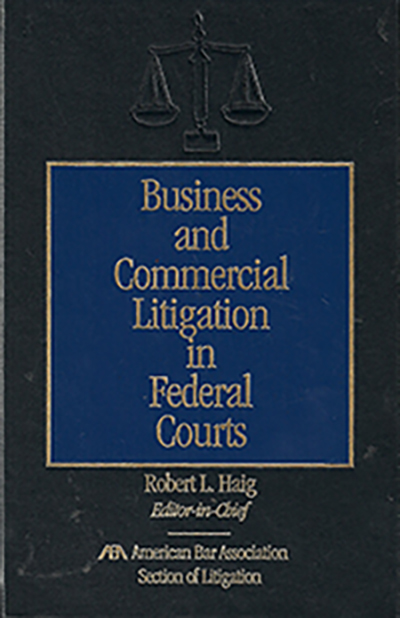
The fifth edition of “Business and Commercial Litigation in Federal Courts” edited by Robert L. Haig is a monumental work built on the foundation of the first four editions.1 This treatise is an exhaustive, in-depth guide to litigating in the federal courts, much of which can also be helpful for state court practice.
Indeed, this edition contains chapters on almost everything you would expect to be covered in a definitive treatise on this subject — and even more. Given its breadth, it is not something most litigators would read from start to finish. Rather, it is a resource for the business litigator. When the need arises, it is there. It includes explanations of the law, and also adds ideas and practical advice gained from the years of experience of the 373 principal authors (including 32 distinguished judges and many exceptional members of the commercial litigation bar nationwide). Practice checklists, jury instructions, and an abundance of forms are also included.
The fifth edition includes 18 volumes, more than 23,000 pages, 180 chapters (26 of them on new topics),2 and upwards of 50,000 case citations. New chapters include such hot topics as climate change; corporate sustainability and environmental, social, and governance factors; shareholder activism; use of jury consultants; valuation of a business; and virtual currencies.
topics),2 and upwards of 50,000 case citations. New chapters include such hot topics as climate change; corporate sustainability and environmental, social, and governance factors; shareholder activism; use of jury consultants; valuation of a business; and virtual currencies.
The chapters are well-researched and contain abundant footnotes. They are easy to navigate and include thousands of cross-references to other sections. They are comprehensive, practical, and well-organized. At $2,088, the cost is significant, but the volumes of material, analyses, case citations, and strategic considerations are prodigious. Updates are in pocket parts.
The foreword states one of the authors’ main objectives “is to provide commercial litigators with enough information so they can do almost everything they need to without any further guidance from anyone else.” With that in mind, we will briefly focus on a few chapters that may be of particular interest.
Chapter 11: Comparison with Commercial Litigation in State Courts discusses many important factors to consider in deciding whether to file in state court versus federal court. Simply because federal jurisdiction is available doesn’t mean you automatically want to file in federal court.
Chapter 72: Litigation Avoidance and Prevention contains a reminder: The lawyer is both attorney and counselor. Other important reminders include seek early resolution;3 consider including alternative dispute resolution provisions in the contracts; enforce sound internal policies and procedures; and before filing suit, know what damages will be available and how they will be calculated.
Chapter 83: Teaching Litigation Skills is a critical issue right now. How can we train new litigators when so few cases go to trial?4 Here, the authors recommend numerous books and treatises on various aspects of litigation and provide helpful tips on oral advocacy. As to written work, the authors recommend, among other things, preparing an outline and ruthless editing.
Chapter 96: Director and Officer Liability offers an interesting perspective of director and officer (D&O) liability from the viewpoint of both an attorney and a judge. It includes an analysis of the duties of due care, loyalty, and disclosure for directors and officers.5 Of particular interest is the analysis of the special attorney-client privilege considerations involving D&O litigation and D&O insurance.
Chapter 97: Shareholder Activism is a broad concept that relates to many strategies involving shareholders in public companies. Generally, activist investors seek to quietly accumulate stakes in public companies. Social activists have shifted their emphasis to the governance practices of a target company. This chapter covers various topics including accumulating a stake in a company, pursuing a takeover, initiating a proxy contest, shareholder proposals, and Section 16(b) claims.
Chapter 98: Corporate Sustainability and ESG discusses the ever-growing body of law involving environmental, social, and governance (ESG) concepts facing publicly traded U.S. companies. It explains how ESG has been used in far-reaching areas such as climate change. The chapter offers insight into the complex relationship between society and publicly traded corporations and how litigation can be used to influence corporate decisions.
Chapter 104: Health Care Institutions opens with a section designed to assist counsel navigating disputes between a health care provider and Medicare through the administrative review process to judicial review in federal court. The authors next discuss key issues of litigation under various federal health care statutes. They examine the effects of state privacy laws on discovery in the context of medical staff and peer review litigation. The final section addresses the False Claims Act, the Stark law, and the Medicare Anti-Kickback Statute. The authors also examine various antitrust challenges for health care providers.
Chapter 136: Fiduciary Duty Litigation is especially helpful in discussing ethical considerations in representing a fiduciary. These include conflicts of interest as well as settlement agreements and releases. The authors also identify issues that may cause a breach of fiduciary duty resulting in litigation.6
Chapter 148: Commercial Real Estate covers topics such as foreclosures, substantive due process claims, and takings claims that arise in zoning and partnership disputes. The chapter also analyzes COVID-19 and its impact on the real estate market.
Whether your focus is business litigation in federal or state courts, this treatise is very valuable and well done. Its case citations alone are impressive, but its analyses, practical tips, and forms make it a definitive treatise on business and commercial litigation in federal courts.
The authors would like to thank colleagues Theresamarie Mantese and M. Jennifer Chaves for their excellent contributions.